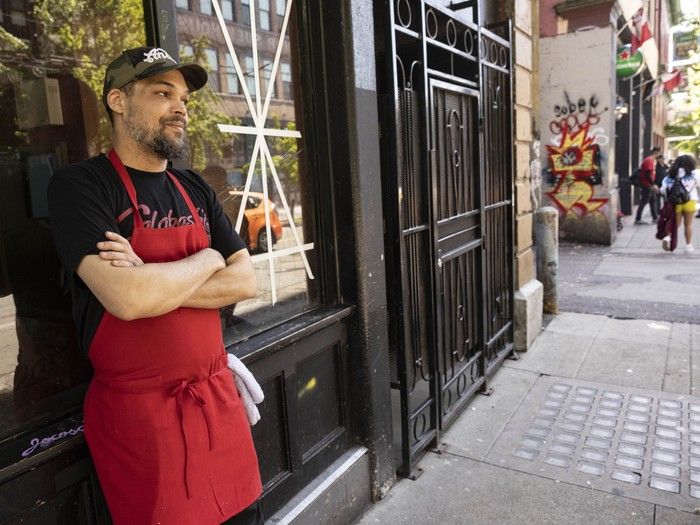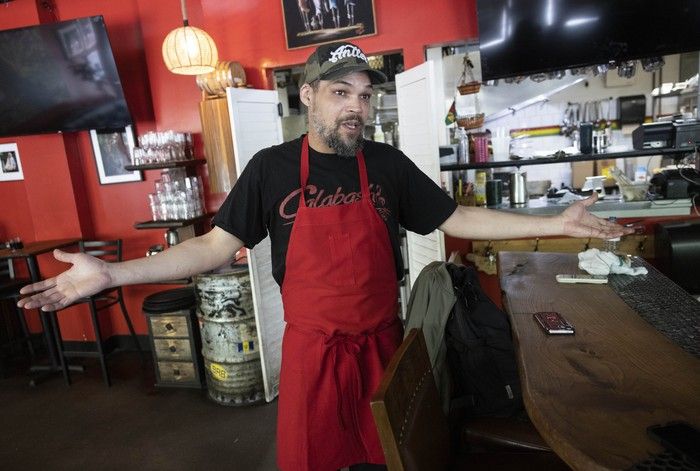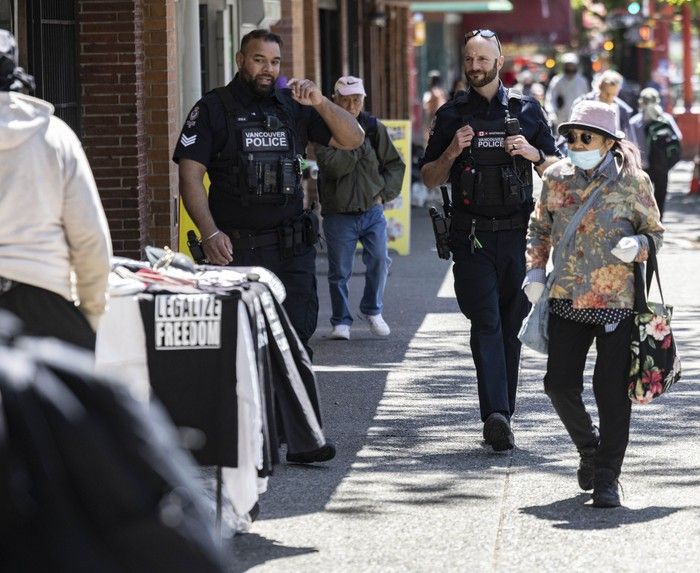
Vancouver’s Cullin David was posing for a photograph inside his Downtown Eastside restaurant on Thursday afternoon, discussing crime in the neighbourhood, when he noticed a man outside tagging his front window.
“Look at that,” said David, head chef and co-owner of Calabash, a Caribbean restaurant. “Excuse me.”
With that, he stepped out onto Carrall Street and followed the tagger into an alley, where he asked him to hand over his Sharpie marker, which he snapped in two.
David would never want his staff to confront people like that.
“I don’t want them getting into harm’s way. I don’t want to do that either. But at the same time, if you don’t put your foot down, you continually get run over.”
Crime and public safety have been problems in the neighbourhood long before Calabash opened in 2010. But this block has been significantly more “volatile” in recent years, David said.
David welcomed a Postmedia News reporter and photographer into his restaurant to talk about crime in the Downtown Eastside, hours after the Vancouver Police Department released figures it says shows the success of boosted efforts starting three months ago to curb crime in and around the neighbourhood.
The department says it sent additional officers to Gastown, Chinatown, and Hastings Street, supported by $5 million from city hall. It has officers working overtime to patrol the neighbourhood, helping to deter crime and respond more quickly to incidents.
The funding is expected to last six months.
From David’s perspective, as a longtime owner of a business just steps away from East Hastings Street, crime and disorder doesn’t seem to have dropped much since police started their Task Force Barrage started on Feb. 13.
He does not blame the police.
“Through no fault of their own, the police are playing Whac-a-mole,” David said. “We need the province to come into play, we need mental health facilities, we need more of a holistic focus to improve anything down here.”
While crime doesn’t seem very different in recent months, business at Calabash has been worse since police launched Task Force Barrage, David said.
He believes the public perception of the area as a “war zone” is keeping people away, and if not for some recent catering gigs to keep them afloat, Calabash may have already been forced to close.

Some area business owners expressed more optimism.
Alex Chang, who owns Baldy’s Vintage clothing boutique on East Pender across from the Sun Yat-sen Garden, is in a group chat with other Chinatown business owners, including both newer merchants like him and longtime operators. Much of their talk relates to crime in the neighbourhood, which he says has slowed from several reports daily last fall to one message a day earlier this year. Lately, the group chat is only pinging every few days.
At a news conference Thursday, Sgt. Steve Addison said: “We’ve had more police officers out on the street in the Downtown Eastside and surrounding areas over the past three months than we have in years. And crime has plummeted.”
Since the task force’s launch, police say violence and most property crimes in those neighbourhoods have declined compared to 2024, with violent crime dropping 13 per cent in the Downtown Eastside and Gastown, 26 per cent in Chinatown and 14 per cent in Strathcona.
The department says officers have seized 745 weapons — including 79 guns — made 414 warrant arrests, and filed 258 reports to prosecutors.
Addison did not have figures on the number of convictions or recommendations to Crown counsel resulting from the arrests made by the task force. “The process for (suspects) working their way through the court to a conviction could take months, 18 months, or longer.”
He said the figures show that serious assaults, robberies and commercial break and enters in those areas have also dropped, as have residential break and enters, with the exception of Gastown, which has had no change when compared to 2024.
The biggest declines were for commercial break and enters, ranging from 42 per cent in the Downtown Eastside to 86 per cent in Chinatown.

Despite progress, Addison described the situation as a continuing struggle due to factors including mental health and drug use, as well as challenges when violent offenders are released from institutions and sent to halfway houses in the neighbourhood.
“It feels like we’re trying to hold back a leaky dam,” said Addison.
Addison emphasized the need to maintain the momentum of the task force beyond its initial surge.
“We don’t want this task force to come to an end after six months and have all the gains we’ve made, all the progress, go to for naught,” he said.
“There will need to be broader discussions about how to sustain this effort — not just relying on the police department, but involving the community as a whole,” he added, citing senior levels of government, service providers, and community organizations as key partners.
“By having our officers close, we’ve been able to more easily intervene and arrest people, or stop them when they’ve committed thefts,” Addison said.
Police and Vancouver Mayor Ken Sim said when the operation was launched that it would be a “long-term operation to dismantle organized crime networks and target predatory criminals in the Downtown Eastside and beyond.”
Landon Hoyt, executive director of the Hastings Crossing Business Improvement Association, said: “Overall, we are pleased with the results of Task Force Barrage, having seen a noticeable decline in major crime in our area.”
“However, we are also conscious of the chronic systems-level challenges that still persist, which policing will not resolve,” Hoyt said. “We will continue pushing for those services that this community desperately needs.”
With files from The Canadian Press